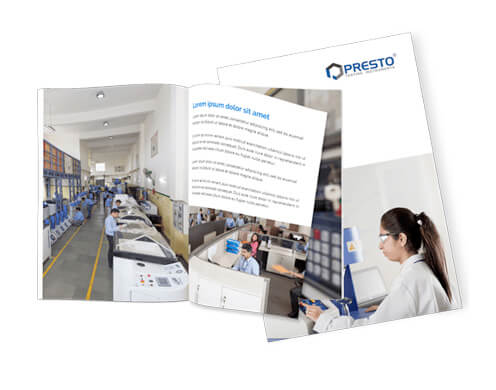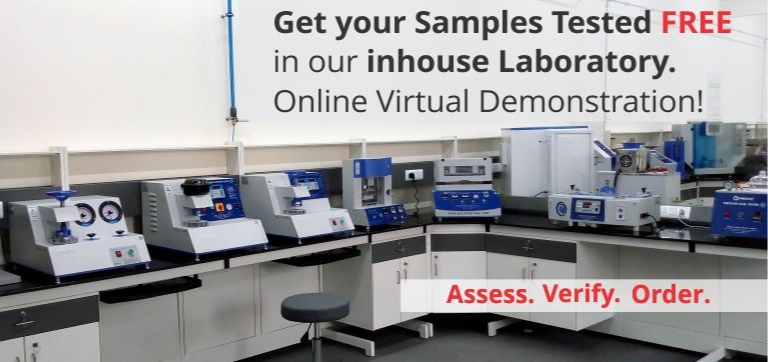How to Measure Water Absorption in Blotting Paper with a Cobb Tester

Vishal Malhotra-Testing Instrument Expert
21-05-2025
Blotting paper is a unique material known for soaking up liquids like ink, water, or oil. It’s used in everything from art and writing to packaging and lab work. To make sure it does its job well, manufacturers test its absorbency using a tool called a Cobb tester. This blog will walk you through what a Cobb tester is, how it works, why it matters for blotting paper, and how to calculate the Cobb value. We’ll keep things simple, answer common questions, and include a handy table to break it all down.
What Does a Cobb Tester Do?
The Cobb tester, or Cobb Water Absorption Tester (its full name), is a device that measures how much water a piece of paper or board soaks up in a specific amount of time. Named after its inventor, it’s a go–to tool in industries like paper production, packaging, and printing. For blotting paper, which is all about absorbing liquids, the Cobb tester is key to checking quality.

The tester itself is pretty straightforward. It has a metal cylinder, a flat base, a rubber mat, and a clamp to hold everything in place. During the test, water is poured into the cylinder, and the paper absorbs it for a set time, usually 60 or 120 seconds. The result, called the Cobb value, tells you how much water the paper took in.
Why Test Blotting Paper with a Cobb Tester?
Blotting paper needs to be super absorbent to do its job, whether it’s soaking up ink for calligraphy, picking up oil in cosmetics, or filtering liquids in a lab. The Cobb tester gives a clear, measurable number—the Cobb value—that shows how well the paper performs. Without this test, it’d be hard to know if one batch of blotting paper is better than another or if it meets the needs of a specific job.

For example, in packaging, some materials need to absorb just the right amount of moisture to protect food or medicine. Too much or too little absorbency can cause problems. The Cobb tester helps manufacturers get it right, ensuring their products are reliable.
How to Run a Cobb Test
Running a Cobb test is simple but requires care to get accurate results. Here’s how it’s done:-
- Cut the Sample:- Take a piece of blotting paper and cut it into a circle, usually 100 square centimeters (about the size of a small plate). Make sure it’s free and smooth of wrinkles.
- Weigh It Dry:- Use a precise scale to weigh the paper before it touches water. Write down this “dry weight.”
- Set Up the Tester: Place the paper on the rubber mat of the Cobb tester. Clamp the cylinder on top to make a tight seal. Pour 100 ml of water into the cylinder so it touches the paper.
- Wait and Drain: Let the water sit for a set time (like 60 seconds). Then, pour out the water and gently blot or roll off any extra water on the paper’s surface.
- Weigh It Wet: Weigh the paper again right away. This is the “wet weight.”
- Find the Cobb Value:- Subtract the dry weight from the wet weight and multiply by 100 to get the Cobb value in grams per square meter (g/m²).
The Cobb Test Formula
The Cobb test formula is easy to follow:
Cobb Value (g/m²) = (Wet Weight – Dry Weight) × 100
- Wet Weight: The paper’s weight after soaking up water (in grams).
- Dry Weight: The paper’s weight before the test (in grams).
- 100: This adjusts the result to grams per square meter, based on the 100 cm² sample size.
For example, if your dry paper weighs 4 grams and the wet paper weighs 6 grams, the math looks like this:
(6 – 4) × 100 = 200 g/m²
So, the blotting paper absorbed 200 grams of water per square meter.
What’s the Cobb Test Unit?
The Cobb test unit is grams per square meter (g/m²). This unit makes it easy to compare different papers. For blotting paper, a high Cobb value like (200–500) g/m² is good because it means the paper soaks up a lot of water. Other papers, like those used for magazines, have lower Cobb values because they are designed to resist water.
Uses of the Cobb Tester
The Cobb tester isn’t just for blotting paper. It’s used in a few different ways:
- Paper and Packaging: It checks if materials like blotting paper or cardboard have the right absorbency for their job, like food packaging or shipping boxes.
- Quality Checks: Factories use it to make sure every batch of paper performs the same way.
- New Product Development: Researchers use the tester to create papers with specific absorbency levels for unique uses.
- Meeting Standards: Many industries follow rules, like ISO 535, that require the Cobb test to prove a product’s quality.
What Can Affect the Test?
To get the right Cobb value, you need to be careful. Here are some things that can mess up the results:
- Test Time: Most tests run for 60 or 120 seconds, but blotting paper might need a shorter time because it absorbs water so fast.
- Water Temperature: The water should be around 23°C (room temperature) for consistent results.
- Sample Condition: If the paper is wrinkled or dirty, the test won’t be accurate.
- Tester Maintenance– The Cobb tester needs to be clean and properly sealed to avoid leaks.
Paying attention to these details helps ensure the test reflects the true absorbency of the blotting paper.
Table: Cobb Values for Common Paper Types
| Paper Type | Cobb Value Range (g/m²) | Common Uses |
| Blotting Paper | 200–500 | Ink blotting, lab filters, cosmetics |
| Uncoated Paper | 20–50 | Notebooks, printer paper |
| Coated Paper | 10–30 | Glossy magazines, brochures |
| Corrugated Board | 50–100 | Cardboard boxes, packaging |
This table shows that blotting paper has a much higher Cobb value than other papers, which makes sense given its job is to soak up liquids.
Cobb Testing: Most Asked Questions
1. What does “Cobb Tester” stand for?
The full name is Cobb Water Absorption Tester. It’s named after the person who invented it and is used to measure how much water paper absorbs.
2. Why is the Cobb test important for blotting paper?
The test shows how well blotting paper soaks up water, which is critical for its uses, like absorbing ink or filtering liquids. It ensures the paper does its job properly.
3. What’s a typical Cobb value for blotting paper?
For blotting paper, a Cobb value between 200 and 500 g/m² is common. Higher values mean the paper is more absorbent, which is usually what you want.
4. Can the Cobb tester be used for things besides paper?
Yes, it can test other materials like cardboard or fabrics, as long as they can be cut into the right size and handle water exposure.
Wrapping It All Together: Cobb Value Insights
The Cobb tester is a simple but powerful tool for checking how much water blotting paper can absorb. By giving a clear number—the Cobb value—it helps manufacturers make sure their paper is up to the task, whether it’s for art, packaging, or science. Using the Cobb test formula and paying attention to details like test time and sample prep, you can get accurate results every time. Next time you use blotting paper, you’ll know the science behind its ability to soak up liquids—and why the Cobb tester matters.
you may also like
- The Ultimate Guide to Lab Testing Equipment: Ensuring Quality with Precision Instruments
- GSM Calculator Guide: How to Measure Fabric, Paper & Plastic Weight
- What Is a Gloss Meter? Working Principle, Uses & Benefits Explained
- Applications of Tensile Testers in Plastic, Metal & Rubber Industries
- How UV Chambers Help Manufacturers Beat Sunlight and Weather Challenges
Recent News
- Paper & Packaging Testing Instruments
- Paint, Plating & Coating Testing Instruments
- Plastic & Polymer Testing Instruments
- Environmental Testing Chambers
- PET & Preform Testing Instruments
- Color Measuring Testing Instruments
- View Entire Range Instruments

Catalogue 2023
Get information about new product launches, research, innovation and endeavors at Presto.
download Free Copy
Get a Quote

